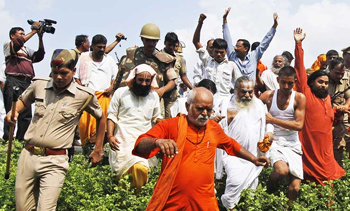 New Delhi, Aug 26: VHP's controversial Ayodhya yatra and subsequent developments paralysed Parliament on Monday with BJP and SP members creating uproar leading to adjournment of both Lok Sabha and Rajya Sabha twice before noon.
New Delhi, Aug 26: VHP's controversial Ayodhya yatra and subsequent developments paralysed Parliament on Monday with BJP and SP members creating uproar leading to adjournment of both Lok Sabha and Rajya Sabha twice before noon.
The Parliament was again adjourned till 2 pm after uproar over VHP yatra and protests by Samajwadi Party members against attack on their office in Delhi.
Immediately after swearing-in of new members in both Houses, MPs from BJP and SP were on their feet creating uproar over the yatra.
In the Lok Sabha, SP members trooped into the Well on the issue, even as BJP members led by Yogi Aditya Nath protested from their seats.
At one point, agitating SP members returned to their seats after Speaker Meira Kumar assured them that their party leader would be allowed to raise the issue.
Aditya Nath argued that he should be given an opportunity to speak first.
Provoked by this, SP members again trooped into the Well. As ruckus continued, the House was adjourned till 11.30 am.
When it reassembled, similar scenes were witnessed and BJP members did not allow SP chief Mulayam Singh Yadav to speak.
Two Congress members from Seemandhra region kept shouting in the Well holding placards demanding united Andhra Pradesh.
Amid din, the House was adjourned till noon.
In the Rajya Sabha, SP members were on their feet alleging attack by BJP workers on their Delhi office, a charge strongly denied by the main opposition party.
Chairman Hamid Ansari's repeated efforts to restore normalcy in the House did not yield result. He first adjourned the House for 15 minutes and then till noon.
Earlier, senior Congress leader BK Hariprasad, who was elected from Karnataka to the Upper House, took oath.
In the Lok Sabha, two newly elected Congress MPs from Karnataka - actress-turned politician Ramya and D K Suresh - took oath as new members.
The Uttar Pradesh government on Sunday stopped VHP from carrying out its "84 kosi parikrama yatra".
Live updates from Parliament:
* BJP MP Yogi Adityanath said in Lok Sabha that high court had recognised Ayodhya as the birthplace of Lord Ram and government should bring in a law for Ram temple.
* He further added that VHP was only seeking its rights with the 84 kos yatra.
* He slammed the Samajwadi Party for creating a jungle raj in Uttar Pradesh and demanded that the state government be dismissed. he further added that SP was changing the meaning of secularism.
* He went on to slam the Uttar Pradesh government of providing shelters to jehadis and thus hurting sentiments of Hindus.
* Samajwadi Party chief Mulayam Singh Yadav said in Lok Sabha that the UP government was following Supreme Court orders and had therefore banned VHP yatra.
* He said that the BJP wanted to garner votes though 'danga' (riots) during yatra.
* When asked about the BJP protests on VHP yatra crackdown by Uttar Pradesh Police, he said, "Tell me, did anybody get hurt?"
* Nobody in Uttar Pradesh supported the VHP yatra: Mulayam Singh Yadav
* We stopped these hooligans in 90s and will stop them again: Mulayam Singh Yadav in Lok Sabha
* Ayodhya matter is not new, the matter is pending in the court: Mulayam Singh Yadav
* This is plain 'goondaism' of the BJP: Mulayam Singh Yadav





Comments
Add new comment